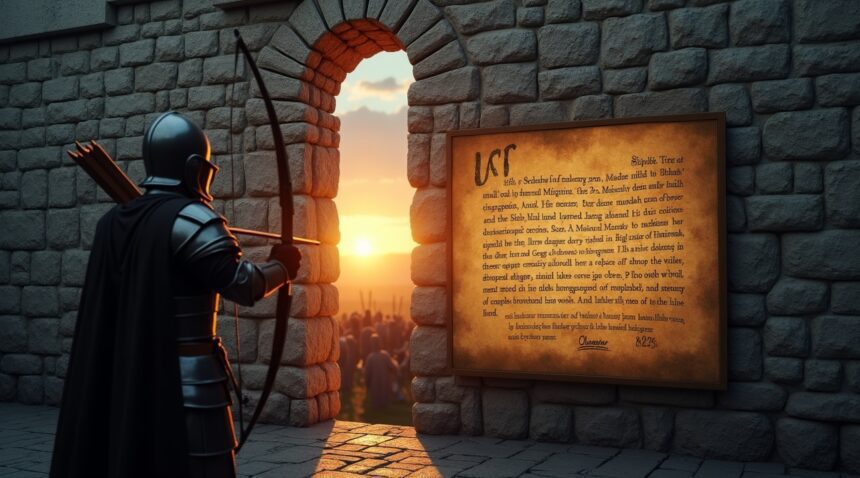The term “loophole” has undergone a fascinating evolution from its architectural roots in medieval castles to its present-day usage in legal and cultural contexts, highlighting both the adaptability of language and the enduring relevance of strategic advantage.
Key Takeaways
- The word “loophole” first appeared in the mid-15th century, combining “loupe” (Middle English for narrow window) with “hole” to describe defensive slits in castle walls.
- Medieval castle builders deliberately designed these narrow openings as strategic defensive features, allowing defenders to observe enemies and launch arrows while staying protected behind stone fortifications.
- The linguistic transition from architectural to legal terminology occurred gradually during the 17th century, with early literary works such as Robinson Crusoe and Oliver Twist demonstrating the metaphorical usage.
- Modern legal terminology distinguishes between loopholes (flaws within existing laws that allow circumvention) and lacunae (complete gaps where no applicable law exists).
- Contemporary culture has coined numerous derivative phrases like “boyfriend loophole” and “corporate loophole,” illustrating the term’s ongoing relevance and flexibility in addressing diverse issues.
From Castle Walls to Legal Gaps: The Surprising Journey of a Medieval Defense Term
The word “loophole” carries a fascinating history that stretches back over five centuries, beginning its life in a completely different context than we know today. I find it remarkable how a term describing medieval fortress architecture eventually evolved into our modern understanding of legal and regulatory gaps.
Medieval Origins: Defense Through Design
During the mid-15th century, English speakers first coined the term “loop-hole” by combining two distinct elements. The first part, ‘loupe,’ came from Middle English and meant “narrow window” or “slit-opening in a wall.” The second component, “hole,” needs little explanation. This architectural feature served a critical defensive purpose in castle construction, creating narrow vertical slits that allowed defenders to observe approaching enemies and launch arrows while staying protected behind thick stone walls.
Castle builders understood the tactical advantage these openings provided. Archers could position themselves safely behind fortifications while maintaining visual contact with attackers. The design was both practical and ingenious—offering maximum protection while enabling effective counterattacks. These defensive slits, also called arrowslits, became standard features in military architecture across Europe during this period.
Etymology Reveals Strategic Intent
The linguistic roots of “loophole” reveal even deeper connections to surveillance and defense. Scholars trace the etymology back to Middle Dutch ‘lupen,’ which meant “to watch” or “to peer.” Medieval Latin also contributed related terms like ‘loupa’ and ‘lobia,’ both emphasizing concepts of vigilance and observation. This linguistic foundation reinforces how the original loophole represented purposeful design rather than accidental oversight.
Castle designers didn’t create these openings by accident or as construction flaws. Instead, they deliberately incorporated loopholes as strategic elements that balanced defensive needs with offensive capabilities. The narrow design prevented enemy arrows from easily entering while providing defenders with adequate space to return fire. This calculated approach to fortress construction demonstrates how medieval architects understood the importance of controlled access points.
The transition from describing architectural features to representing legal or regulatory gaps happened gradually over several centuries. Modern usage maintains some connection to the original meaning—both involve finding ways to see through barriers that others might consider solid. Whether examining castle walls for defensive opportunities or legal documents for advantageous interpretations, the core concept of discovering openings remains consistent. This evolution shows how language adapts while preserving essential meanings, allowing ancient military terminology to describe contemporary legal strategies.

How Medieval Warriors Gave Birth to Modern Legal Language
The transformation of “loophole” from medieval architecture into modern legal terminology represents one of language’s most fascinating evolutionary journeys. During the 17th century, English speakers began using this once-concrete term in entirely new ways, shifting from physical descriptions to abstract concepts that would shape legal discourse for centuries to come.
From Stone Walls to Legal Walls
The metaphorical leap from castle defenses to legal defenses wasn’t accidental. Early English speakers recognized striking similarities between the defensive strategies employed by medieval warriors and the protective measures people sought in legal matters. Just as castle defenders used narrow architectural openings to shield themselves while mounting counterattacks, individuals began exploiting small gaps in legislation to protect their interests or escape unwanted restrictions.
This conceptual evolution maintained the original intent of the term while expanding its application. The narrow path of retreat that once saved lives in battle transformed into narrow pathways through complex legal frameworks. Writers and speakers found the comparison so apt that “loophole” naturally transitioned from describing physical slits in stone walls to describing conceptual holes in legal documents.
Literary Evidence of Linguistic Change
Early literary works provide compelling evidence of this semantic shift. Daniel Defoe’s Robinson Crusoe (1719) and Charles Dickens’ Oliver Twist (1838) both demonstrate how writers began employing “loophole” in its figurative sense, moving far beyond architectural descriptions. These authors recognized that readers could easily grasp the connection between finding a small opening in a fortress and discovering an unexpected escape route through legal or social constraints.
The appeal of this metaphor lay in its visual clarity and emotional resonance. People could immediately understand how someone might slip through a gap in rules just as a defender might fire through a gap in stone. The term carried implications of both cleverness and defensiveness—qualities that applied equally well to legal maneuvering and military tactics.
Authors found particular value in this evolving terminology because it conveyed complex legal concepts through familiar imagery. Rather than explaining abstract legal principles, they could reference something readers had encountered in stories about castles and warfare. This accessibility helped establish “loophole” as a permanent fixture in legal vocabulary.
The linguistic transition also reflected broader changes in how English speakers thought about law and authority. Medieval concepts of defense and protection influenced how people approached legal challenges, creating natural connections between military strategy and legal strategy. The idea that one could exploit a small opening to avoid restriction became central to understanding both historical warfare and contemporary legal practice.
Modern legal language owes much to this medieval heritage. Today’s discussions of regulatory escape routes and legal ambiguities draw directly from imagery established centuries ago by castle builders and their adversaries. The term’s journey from stone fortifications to courtroom arguments demonstrates how practical military needs can shape abstract intellectual concepts, creating linguistic bridges between vastly different periods and practices.
This evolution continues today as legal professionals, journalists, and ordinary citizens use “loophole” to describe gaps in everything from tax codes to international treaties. The medieval warrior’s narrow window for survival has become the modern citizen’s narrow path through complex regulatory systems, proving that some metaphors possess enduring power across centuries of linguistic change.
The Castle Defense System That Changed Language Forever
Medieval fortress builders revolutionized warfare through narrow vertical slits cut into castle walls. These architectural features, positioned strategically throughout defensive structures, allowed archers and crossbowmen to observe approaching enemies while remaining protected behind thick stone fortifications. The slits provided just enough space for weapons to extend through, creating deadly firing positions that maximized defensive advantage.
Military engineers recognized the effectiveness of these openings and standardized their use across castle construction. Guards could monitor vast territories through multiple viewing angles, coordinating defensive responses without exposing themselves to enemy fire. The narrow design prevented attackers from returning effective shots while maintaining clear sight lines for defenders.
From Architecture to Action
The construction process of creating these defensive openings generated its own terminology within military circles. Engineers and builders began using “to loophole” as an active verb, describing the specific task of cutting and positioning these slits throughout fortification walls. This military language spread beyond construction sites as soldiers and commanders adopted the term in their operational vocabulary.
U.S. military forts during the 19th century expanded this architectural concept extensively. Fort designers incorporated sophisticated loophole systems that enhanced traditional defensive strategies while adapting to evolving warfare technologies. These installations demonstrated how effective the concept remained even as military tactics advanced.
The transition from literal to figurative meaning reflects a fascinating linguistic evolution. People began drawing parallels between physical gaps in walls and conceptual gaps in legal documents or regulations. Just as castle defenders exploited narrow openings to their advantage, individuals discovered they could exploit small oversights in written agreements or laws to achieve similar strategic benefits.
This metaphorical shift captures the essence of both applications perfectly. Whether discussing stone fortifications or complex contracts, loopholes represent opportunities for circumvention through careful observation and strategic action. The original defensive purpose—using small spaces to resist larger forces—mirrors exactly how people use legal or regulatory gaps to resist unwanted restrictions or obligations.
Modern usage maintains this connection between the architectural origin and contemporary applications. Contract lawyers search for textual gaps with the same methodical approach that medieval guards scanned horizons through castle slits. Both require patience, attention to detail, and understanding of how small openings can provide significant advantages in challenging situations.
The enduring power of this terminology demonstrates how military innovations can reshape language far beyond their original context, creating metaphors that remain relevant centuries after the last castle loophole served its defensive purpose.

Today’s Legal Landscape: When Gaps Become Gateways
Modern usage of “loophole” has crystallized into an almost exclusively legal concept that describes specific weaknesses in laws and regulations. I observe that contemporary society uses this term to identify ambiguities, technical flaws, or gaps that allow individuals or corporations to circumvent intended legal consequences. This evolution represents a sharp departure from the word’s humble architectural origins.
Legal professionals and lawmakers now employ “loophole” to highlight how careful parsing of statutory language can create unexpected escape routes. The term has become essential vocabulary for describing situations where the letter of the law diverges from its spirit, allowing clever interpretation to undermine legislative intent.
Distinguishing Loopholes from Legal Gaps
Understanding the distinction between loopholes and lacunae proves crucial for precise legal discussion. A loophole exists within existing law—it represents a flaw in drafting or an unintended consequence of specific wording that creates an avenue for avoidance. Lacunae, conversely, describe complete absences of applicable law where no regulation exists to address particular situations.
This differentiation matters because loopholes typically require sophisticated legal maneuvering to exploit existing statutory frameworks, while lacunae simply represent unregulated territory. The following examples illustrate how various sectors experience loophole exploitation:
- Tax loopholes enable corporations to minimize obligations through complex structural arrangements that technically comply with code language while violating underlying policy objectives
- Immigration loopholes allow individuals to exploit procedural gaps or definitional ambiguities to achieve outcomes contrary to immigration law’s broader purposes
- Contractual loopholes permit parties to escape obligations through precise interpretation of agreement terms that diverge from apparent mutual understanding
Each category demonstrates how technical precision can subvert practical intention. Tax authorities worldwide struggle with multinational corporations that establish elaborate subsidiary structures to shift profits through jurisdictions with favorable treatment. These arrangements often comply with existing regulations while dramatically reducing effective tax rates compared to legislative expectations.
Immigration systems face similar challenges when individuals identify procedural shortcuts or definitional gaps that permit entry or status changes despite failing to meet policy objectives. Marriage-based immigration, student visa programs, and asylum procedures all contain potential vulnerabilities that skilled practitioners can exploit.
Contract law encounters loophole issues when parties draft agreements with sufficient ambiguity to create interpretive wiggle room. Insurance policies particularly suffer from this phenomenon, where coverage disputes arise from careful parsing of exclusionary language that insurers use to deny claims that policyholders reasonably expected to be covered.
Modern legislative drafting attempts to anticipate potential loopholes through comprehensive language and broad definitional frameworks. However, the complexity of contemporary legal systems makes complete closure nearly impossible. Each new regulation potentially creates fresh opportunities for creative interpretation by those motivated to find alternative compliance paths.
Technology has amplified loophole discovery and exploitation capabilities. Legal research software enables rapid analysis of statutory language across multiple jurisdictions, while sophisticated modeling allows prediction of regulatory interpretation outcomes. This technological advancement has accelerated the identification of potential gaps and increased pressure on lawmakers to craft more precise legislation.
The term “loophole” now functions as a critical analytical tool for evaluating legislative effectiveness. Policymakers use it to identify areas where laws fail to achieve intended outcomes, while advocates employ it to highlight systemic unfairness in regulatory frameworks. Legal scholars examine loopholes to understand how statutory interpretation evolves and how drafting techniques can better align law with policy objectives.
This contemporary understanding positions loopholes as inevitable features of complex legal systems rather than mere drafting errors. Recognition of this reality has shifted focus from attempting perfect closure toward developing adaptive regulatory frameworks that can evolve with changing interpretation patterns and emerging avoidance strategies.
Modern Derivatives and Cultural Impact
The term “loophole” has generated countless derivative phrases that permeate contemporary discourse, proving its remarkable adaptability across diverse contexts. I observe how this medieval fortress term has transformed into one of the most versatile metaphors in modern language, spawning expressions that range from serious political commentary to playful wordplay.
Contemporary Phrase Evolution
Modern derivatives showcase the term’s flexibility in addressing current issues. The “boyfriend loophole” emerged as a pointed critique in U.S. gun legislation debates, highlighting gaps in background check requirements for domestic violence perpetrators. This phrase demonstrates how speakers adapt the loophole concept to address contemporary policy concerns with precision and urgency.
Legal and business contexts have produced numerous variations that extend the metaphor’s reach:
- Corporate loophole describes tax avoidance strategies that exploit regulatory gaps
- Insurance loophole refers to policy language that allows claim denials
- Contract loophole identifies escape clauses or ambiguous terms
- Visa loophole highlights immigration system vulnerabilities
Idiomatic expressions have cemented the term’s place in everyday conversation. The saying “every law has a loophole” reflects widespread cynicism about regulatory effectiveness, while phrases like “closing the loophole” and “exploiting loopholes” have become standard political rhetoric. These expressions carry the weight of the original military metaphor—suggesting both vulnerability and strategic advantage.
Cultural Resonance and Linguistic Evolution
Humorous variations reveal the term’s penetration into popular culture. The “lo mein loophole” represents playful manipulation of the sound structure, while similar wordplay appears in comedy, social media, and casual conversation. This linguistic creativity demonstrates how deeply the concept has embedded itself in collective consciousness.
The transformation from physical aperture to abstract concept illustrates language’s capacity to evolve alongside societal structures. I find that the word’s journey mirrors humanity’s shift from physical fortifications to complex legal and social systems requiring similar strategic thinking. The original castle defenders who shot arrows through stone slits share conceptual DNA with modern individuals navigating bureaucratic or legal challenges.
Contemporary usage maintains strong connections to the martial origins while expanding interpretive possibilities. The imagery of finding an opening, exploiting weakness, and gaining tactical advantage resonates across contexts from corporate boardrooms to personal relationships. This metaphorical richness explains why the term continues generating new applications centuries after its literal military relevance diminished.
Digital culture has accelerated the term’s evolution, with online communities creating specialized variations for specific contexts. Gaming communities discuss “gameplay loopholes”, while social media users identify “algorithm loopholes” for increased visibility. These modern applications preserve the core concept while adapting to technological realities.
The persistence and proliferation of loophole derivatives reflect broader cultural attitudes about rules, authority, and individual agency. The term carries implicit acknowledgment that systems contain flaws and that resourceful individuals can exploit these weaknesses. This dual nature—simultaneously criticizing system failures while celebrating human ingenuity—explains its enduring appeal across political and social spectrums.
Language scholars note how the word’s phonetic structure contributes to its memorability and adaptability. The combination of “loop” and “hole” creates vivid mental imagery while remaining easy to modify for creative applications. This linguistic accessibility has facilitated its spread across educational levels and social groups.
The term’s cultural impact extends beyond mere vocabulary expansion. It has shaped how speakers conceptualize problems, identify solutions, and communicate strategic thinking. Modern professionals routinely search for loopholes not just in legal documents but in market regulations, software systems, and organizational policies. This widespread application demonstrates how a single medieval military term has become essential to contemporary strategic discourse.
The loophole concept continues evolving as new systems emerge requiring navigation and exploitation. Its linguistic journey from castle walls to modern metaphor exemplifies language’s dynamic relationship with changing human needs and technological advancement.

Sources:
Etymonline – “loophole”
Grammarist – “loophole”
Wiktionary – “loophole”
Wikipedia – “Loophole”
Dictionary.com – “loophole”


